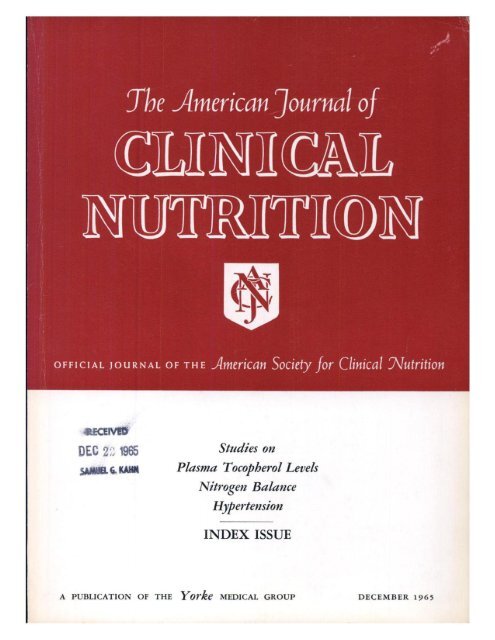Human milk feeding practices and serum immune profiles of one-year-old infants in the CHILD birth cohort study
IF 6.5
1区 医学
Q1 NUTRITION & DIETETICS
引用次数: 0
Abstract
Background
Breastfeeding and human milk consumption are associated with immune system development; however, the underlying mechanisms and the impact of different infant feeding practices are unclear.
Objectives
This study aimed to investigate how current human milk feeding (HMF) status is related to infant immune biomarker profiles, as well as explore relationships with HMF history (i.e., duration, exclusivity, and method: directly from the breast or pumped and bottled).
Methods
This observational birth cohort study involved 605 infants from the Canadian CHILD Cohort Study. Infant feeding was captured from hospital birth records and parent questionnaires. Ninety-two biomarkers reflecting immune system activity and development were measured in serum collected at 1 y (12.6 ± 1.4 mo) using the Olink Target 96 Inflammation panel. Associations were determined using multivariable regression (adjusted for sex, time until blood sample centrifugation, and study site).
Results
Nearly half (42.6%) of infants were still receiving HMF at the time of blood sampling. Compared with non-HMF infants, HMF infants had higher levels of serum fibroblast growth factor 21 (FGF-21, adjusted standardized β coefficient: 0.56; 95% CI: 0.41, 0.72), cluster of differentiation 244 (CD244, β: 0.35; 95% CI: 0.19, 0.50), chemokine ligand 6 (CXCL6, β: 0.34; 95% CI: 0.18, 0.50), and chemokine ligand 20 (CCL20, β: 0.26; 95% CI: 0.09, 0.42) and lower extracellular newly identified receptor for advanced glycation end-products binding protein (EN-RAGE, β: −0.16; 95% CI: −0.29, −0.03). Among non-HMF infants, serum interleukin 7 (IL-7) had a marginally positive association with past HMF duration (β: 0.05; 95% CI: 0.02, 0.08) that persisted for ≤5 mo post-HMF cessation. Exclusive HMF duration and HMF method (at 3 mo of age) were not associated with any biomarkers.
Conclusions
Current HMF status and (to a lesser extent) HMF history are associated with several inflammation-associated biomarkers in 1-y-old infants. These results provide new evidence that HMF impacts immune activity and development and suggest hypotheses about the underlying mechanisms. They also highlight the importance of including current HMF status in immune system–focused infant serum proteomic studies.
CHILD 出生队列研究中一岁婴儿的母乳喂养方式和血清免疫图谱。
背景:母乳喂养和人奶消费与免疫系统的发育有关;然而,其潜在机制和不同婴儿喂养方式的影响尚不清楚:本研究旨在调查当前母乳喂养(HMF)状况与婴儿免疫生物标志物特征之间的关系,并探讨与母乳喂养历史(即持续时间、排他性和方法:直接从母乳喂养,或泵奶和瓶装)之间的关系:这项观察性出生队列研究涉及加拿大儿童队列研究(CHILD Cohort Study)中的 605 名婴儿。婴儿喂养情况通过医院出生记录和家长问卷调查获得。使用 Olink Target 96 Inflammation 面板测量了一岁时(12.6±1.4 个月)收集的血清中 92 个反映免疫系统活动和发育的生物标志物。采用多变量回归法(根据性别、血液样本离心时间和研究地点进行调整)确定了相关性:结果:近一半(42.6%)的婴儿在采血时仍患有 HMF。与非 HMF 婴儿相比,HMF 婴儿血清中成纤维细胞生长因子 21(FGF-21,调整后标准化 β 系数=0.56;95%CI=0.41,0.72)、分化簇 244(CD244,β=0.35;0.19,0.50)、趋化因子 Ligig(CD244,β=0.19,0.50)、钙化因子 Ligig(CD244,β=0.19,0.50)和钙化因子 Ligig(CD244)的水平较高。50)、趋化因子配体 6(CXCL6,β=0.34;0.18,0.50)和趋化因子配体 20(CCL20,β=0.26;0.09,0.42),以及较低的细胞外新识别的高级糖化终产物结合蛋白受体(EN-RAGE,β=-0.16;-0.29,-0.03)。在非HMF婴儿中,血清白细胞介素7(IL-7)与过去的HMF持续时间略呈正相关(β=0.05;0.02,0.08),这种关系在停止HMF后持续长达5个月。专属HMF持续时间和HMF方法(三个月大)与任何生物标志物均无关联:结论:当前的 HMF 状态和(在较小程度上)HMF 历史与一岁婴儿的几种炎症相关生物标志物有关。这些结果提供了 HMF 影响免疫活动和发育的新证据,并对其潜在机制提出了假设。它们还强调了在以免疫系统为重点的婴儿血清蛋白质组学研究中纳入当前 HMF 状态的重要性。
本文章由计算机程序翻译,如有差异,请以英文原文为准。
求助全文
约1分钟内获得全文
求助全文
来源期刊
CiteScore
12.40
自引率
4.20%
发文量
332
审稿时长
38 days
期刊介绍:
American Journal of Clinical Nutrition is recognized as the most highly rated peer-reviewed, primary research journal in nutrition and dietetics.It focuses on publishing the latest research on various topics in nutrition, including but not limited to obesity, vitamins and minerals, nutrition and disease, and energy metabolism.
Purpose:
The purpose of AJCN is to:
Publish original research studies relevant to human and clinical nutrition.
Consider well-controlled clinical studies describing scientific mechanisms, efficacy, and safety of dietary interventions in the context of disease prevention or health benefits.
Encourage public health and epidemiologic studies relevant to human nutrition.
Promote innovative investigations of nutritional questions employing epigenetic, genomic, proteomic, and metabolomic approaches.
Include solicited editorials, book reviews, solicited or unsolicited review articles, invited controversy position papers, and letters to the Editor related to prior AJCN articles.
Peer Review Process:
All submitted material with scientific content undergoes peer review by the Editors or their designees before acceptance for publication.

 求助内容:
求助内容: 应助结果提醒方式:
应助结果提醒方式:


